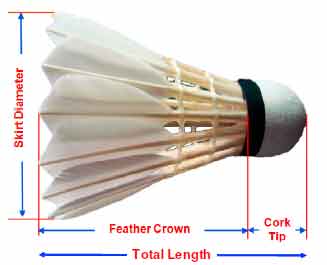For badminton players: “The centre piece of the game is no doubt a
shuttlecock which is made of either natural feathers or synthetic rubber
with an open conical shape.”
But perhaps some are left wondering which
is best from an aerodynamic point of view – a feathered ‘bird’ or a rubber one?
“Although a series of studies on aerodynamic behaviour of spherical and ellipsoidal balls have been reported in the open literature, scant information is available in the public domain about the aerodynamic behaviour of badminton shuttlecocks.”
 This lamentable lacuna in the literature has lately been filled. Firoz Alam
of the School of Aerospace, Mechanical and Manufacturing Engineering,
Royal Melbourne Institute of Technology (RMIT) University, Bundoora,
Melbourne, Australia, undertook (along with colleagues Harun Chowdhury,
Aleksandar Subic, and Chavaporn Theppadungporn)
a wind-tunnel study to evaluate the nondimensional drag coefficient of
not only traditional feather shuttlecocks, but also the more recently
introduced rubber (or plastic) variants.
This lamentable lacuna in the literature has lately been filled. Firoz Alam
of the School of Aerospace, Mechanical and Manufacturing Engineering,
Royal Melbourne Institute of Technology (RMIT) University, Bundoora,
Melbourne, Australia, undertook (along with colleagues Harun Chowdhury,
Aleksandar Subic, and Chavaporn Theppadungporn)
a wind-tunnel study to evaluate the nondimensional drag coefficient of
not only traditional feather shuttlecocks, but also the more recently
introduced rubber (or plastic) variants.
A total of ten shuttlecocks were sequentially secured to a specially
constructed pedestal (a.k.a. a ‘sting mount’) inside the RMIT
Industrial Wind Tunnel - and exposed to a range of windspeeds (60, 80,
100 and 120 km/h). Experimental
findings showed up notable variations in drag coefficients between the
standard feather and synthetic shuttlecocks.
It is believed that these
variations are due to structural deformation of the synthetic
shuttlecocks at high speeds (though further research is needed to
clarify this aspect).
The net results :
“The natural feather shuttlecock displayed lower drag coefficient at low speeds and significantly higher drag at high speeds. On the other hand, the synthetic shuttlecock demonstrated the opposite trends.”
Either way, the team point out that -
“The knowledge of aerodynamic properties of shuttlecocks can greatly assist both amateur and professional players to understand the flight trajectory as player requires considerable skills to hit the shuttlecock for the full length of the court.”
The team’s paper ‘Measurements of aerodynamic properties of badminton shuttlecocks’ was presented at the 8th Conference of the International Sports Engineering Association (ISEA) and is published in Procedia Engineering Volume 2, Issue 2, June 2010, Pages 2487-2492 (The Engineering of Sport 8 – Engineering Emotion).





Comments